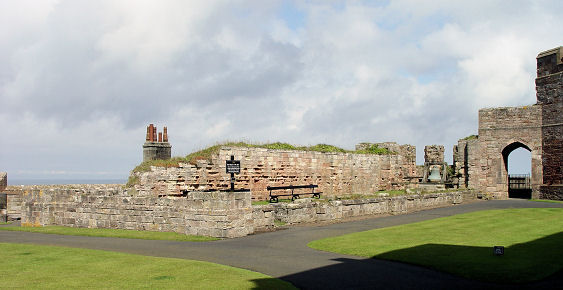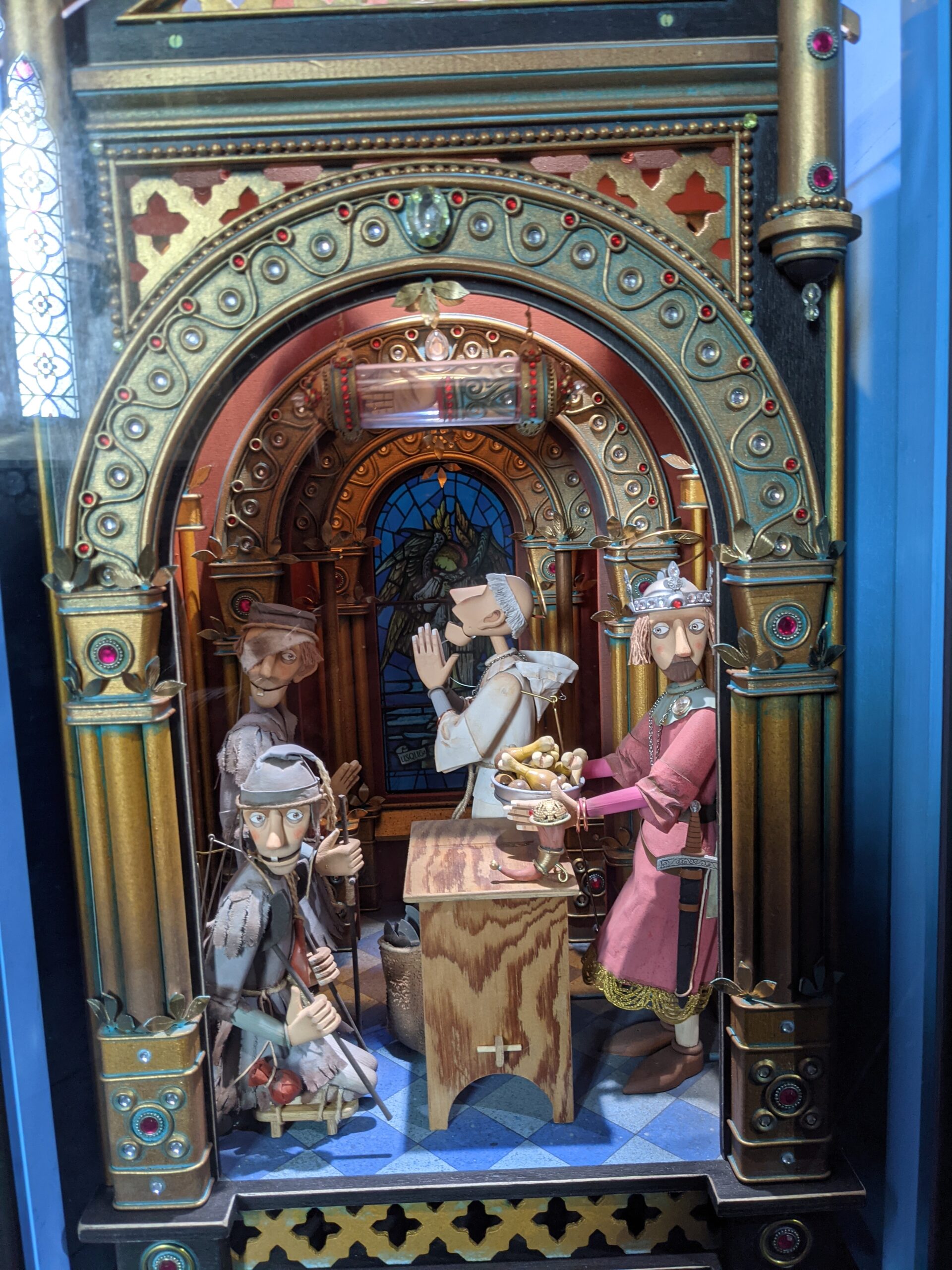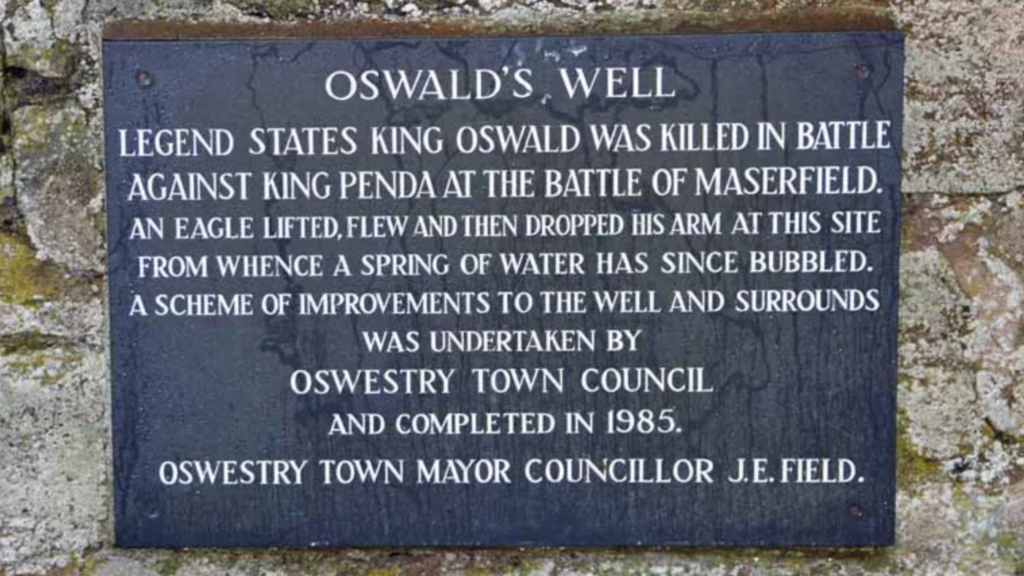In this blog, we explore the story of Oswald and his blessed arm. The story starts at the Chapel of St Peter which would have been the Chapel where Bamburgh’s Anglo-Saxons worshipped during the Anglo-Saxon period.
The chapel of St Peter

The chapel of St Peter, which can be seen in modern-day Bamburgh Castle, is not the same church as would have been there during the Anglo-Saxon time. Parts of the church you can see today were built using Normal remains. During the 18th and 19th centuries, if you had an estate, it was popular to have ruins on it. You’d build a folly if you didn’t have a real ruin on your estate. Here at Bamburgh, they reconstructed the actual location of the Anglo-Saxon church, using Victorian materials. So the church there today isn’t actually a medieval or Anglo-Saxon church, it’s a Victorian folly to give an impression of what the Anglo-Saxon church would have been like.
The Fortress of Bamburgh was the capital city of the Kingdom of Northumbria. This would have consisted of a large area encompassed by a wooden palisade. The important buildings would have been inside the palisade. Next to the modern-day church, also described as a basilica in some of the Anglo-Saxon writings, there would have been a great hall where the Lords would have met. There would also be some accommodation on the site and, further down, there would also be a zone for industry. Everything you needed would have been inside the fortress.
St Oswald

St Oswald
The Chapel of St Peter is quite important in the story of Northumbria because it’s connected to the story of St Oswald – an important King of Northumbria. Oswald was the son of Aethelfrith, a very powerful Northumbrian King. He was influential because he subjugated all the other British Kings around him. Known as ‘The Twister’ Aelfrith became the High King of northern Britain. The Anglo-Saxon name for this was Bretwalda. When he became Bretwalda he forced out his brother-in-law Edwin, the King of Yorkshire, who fled. Throughout the rest of his life, Aelfrith pursued Edwin with the intent of killing him.
Edwin had other ideas, however. A few years later, he summoned up a war band of his own, went to war against Aethelfrith and killed him in battle. When this happened, Aethelfrith’s children fled to Iona on the west coast of Scotland where there was an Irish monastery. As a result, a young Oswald grew up on Iona amongst the Christian community. When he was old enough, he travelled to Ireland where he fought as a warlord, serving various Irish Kings and building up his own Warband.
Back in Northumbria, Edwin enjoyed a successful reign and converted to Christianity. When this happened, Cadwallader, King of Gwynedd, became jealous of him. They had grown up together in North Wales but Cadwallader made a deal with the King of the midlands, Penda of Mercia, to join him in battle against Edwin. They managed to beat him and killed Edwin in battle. Following the death of Edwin, Northumbria was ravaged by Penda and Cadwallader in a campaign that lasted two years. They raided and set fire to the kingdom and attacked the Northumbrians.
Oswald heard of the kingdom’s plight and returned to Northumbria. He brought a massive army with him and, at the Battle of Heavensfield, he fought Cadwallader. He killed Cadwallader, becoming King of Northumbria for the next eight years, introducing his Christian, Celtic faith into the Kingdom. He also brought Irish monks with him who established a small church in Bamburgh, and later, under Aidan, a church on Lindisfarne.
The blessing of Oswald’s arm

Oswald became known for his Christian heart and generosity to the people of Bamburgh and Northumbria. He would eat with Aidan in his great hall and between them they would bless the food of the people in his Hall. This was interesting because it wasn’t common for a King to say grace and bless food. This held echoes of Germanic, pagan rituals where Kings were also High Priests. Not only was Edwin being the High Priest under the Germanic tradition but he was also working with his Bishop, Aidan, in the Christian tradition to bless the food they were about to eat.
As he was about the bless the food, one of his Lords came in to tell him of a crowd gathered outside. They were the poor people of the Kingdom and they were begging for alms, food and help. Oswald was so moved by their plight that he dedicated and donated the food in front of him to these people. He then took out his knife (called a Seax) and cut up the silver bowl he was going to eat from and told his Lord to distribute it to the poor.
Sceptics believe this was a set-up between Oswald and Aidan to show the King’s piety. I don’t think that was the case.
Once the food and silver were distributed, Aidan was so impressed by Aidan’s piety that he took Oswald’s arm, raised it up and blessed it. He said, ‘May this arm never wither.’ The Anglo-Saxons in the hall at the time would have seen this as a Germanic King being blessed so that his arm would always have strength to defend his Kingdom under God’s power and that would have been a symbol of his prowess.
The Fall of Oswald

Oswald then ruled Northumbria for eight years before travelling south to perform a pre-emptive strike on the King of the Midlands, Penda, who was preparing to declare war on Northumbria. They battled in Shropshire and Oswald died during the war. As a Pagan, Penda desecrated Oswald’s body by cutting off his head and arms and placing them on stakes at the battlefield before dedicating his victory to Woden, the king of the Anglo-Saxon gods.
Oswald’s brother Oswiu rode down to Shropshire to reclaim Oswald’s body and brought it back to Bamburgh. Oswald’s head was eventually buried in the tomb of St Aidan on Lindisfarne but it was later moved to lie with St Cuthbert. His head resides in Durham Cathedral to this day. However, across Europe, Oswald became a very popular saint and there are no fewer than nine heads believed to have belonged to Oswald dotted around Europe!
His arms were brought to Bamburgh, placed inside a silver reliquary and laid to rest inside St Peter’s church. People came from all over Northumbria to see the arm of Oswald. It was said that it never decomposed because of the blessing placed upon it by Aidan and was visited by pilgrims right up until the 12th century, according to Simeon the historian.
Around that time, a monk from Peterborough stole Oswald’s arm away from Bamburgh which had fallen into disrepair under the charge of the Normans. The arm and reliquary were placed in a church in Peterborough where it remained until the reformation, when relics such as the arm were seen as idolatry, holding a connection to the old Papal Catholic system. For that reason, many were destroyed.


